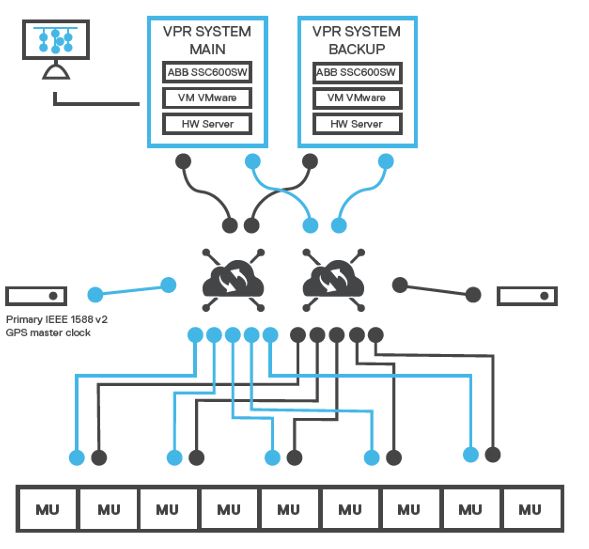The digitalization of substations is transforming the way power systems are protected and controlled. Virtual Protection Relays (VPRs) are a major step in this evolution. Instead of using dedicated hardware devices, protection functions now run as software on virtual machines or high-performance computing platforms.
This shift is made possible by standards such as IEC 61850-9-2 LE and devices like Merging Units (MUs), which convert analog current and voltage signals into digital data streams delivered over Ethernet. These digital streams feed the protection algorithms running inside virtual relays.
Article Content
What Is a Virtual Protection Relay?
A Virtual Protection Relay is a protection system implemented entirely in software instead of a physical relay box. The protection logic—such as overcurrent, distance, and differential functions—runs on:
- Virtual machines (VMs)
- Containers
- Edge-computing servers
- General-purpose computing platforms
In simple terms:
Traditional relay = hardware + firmware
Virtual relay = software running on shared computing infrastructure
This makes VPRs flexible, scalable, and easier to update than electromechanical, static, or numerical protection relays.
Architecture Example of a Virtual Protection Relay System

This diagram shows how a fully digital protection system is structured using Virtual Protection Relays:
- At the top are the Main and Backup VPR Systems, each running protection functions on virtual machines (VMware) hosted on high-performance servers.
- Below them, two redundant Ethernet networks carry Sampled Values (SV) and GOOSE messages to ensure deterministic, fault-tolerant communication.
- On the left, a GPS-synchronized IEEE 1588-v2 PTP clock provides precise timing for both the VPRs and the Merging Units.
- At the bottom, several Merging Units (MUs) digitize CT/VT measurements and stream SV data to the VPRs through the redundant network.
This setup illustrates a fully digital, software-defined protection architecture, where multiple VPR instances can subscribe to the same Sampled Values stream, enabling high availability, fast failover, and complete elimination of analog wiring.
Why Virtual Protection Relays Matter
Utilities and grid operators are exploring VPRs for several reasons:
1. Adapt to Renewable Energy
Solar, wind, and storage introduce fast-changing grid conditions. VPRs can update protection logic quickly without replacing hardware.
2. High Flexibility
Protection functions can be added, modified, or removed through software updates instead of physical relay changes.
3. Lower Cost
Virtualization reduces the number of physical devices, spare parts, wiring, and maintenance needs.
4. Better Testing and Simulation
VPRs can be tested with digital twins, real-time simulations, and virtual substations.
5. Strong Redundancy
Multiple virtual relays can run on the same data stream, enabling hot-standby and fast failover.
How Virtual Protection Relays Work
A typical VPR architecture includes several layers:
1. Hardware Platform
General-purpose servers or edge-computing devices capable of near real-time performance.
2. Virtualization Layer
VMs or container platforms (like Docker/Kubernetes) host individual protection functions, often called virtual IEDs (vIEDs).
3. Protection Software
Software modules that implement protection algorithms:
- Overcurrent
- Distance
- Differential
- Frequency & voltage protection
4. Communication Standards
Protection data is exchanged using IEC 61850 services:
- Sampled Values (SV) for current/voltage measurements
- GOOSE messaging for fast tripping commands
- MMS for SCADA communication
5. Redundancy and Failover
VPR instances can run in parallel and switch instantly if one fails.
6. Testing & Simulation
Digital twins and simulation environments verify performance before deployment.
The Role of IEC 61850-9-2 LE
IEC 61850-9-2 LE defines how digital current and voltage samples (Sampled Values) are transmitted from Merging Units to relays over Ethernet.
What IEC 61850-9-2 LE Specifies
| Concept | Description |
|---|---|
| Purpose | Defines digital transmission of CT/VT samples |
| Sampling Rate | Typically 80 samples per cycle |
| Medium | Redundant Ethernet networks (100 Mbps or 1 Gbps) |
| Data Structure | Sampled Value (SV) frames |
| Key Benefit | Eliminates analog wiring, improves accuracy |
Instead of sending analog signals to every relay, MUs send a single digital SV stream, and multiple VPRs can subscribe to it.
How VPRs Use IEC 61850-9-2 LE and Merging Units
1. Signal Acquisition
Merging Units digitize CT/VT signals and send SV streams via 61850-9-2 LE.
2. Data Subscription
Virtual Protection Relays subscribe to these digital measurements over multicast Ethernet.
3. Real-Time Processing
The VPR software analyzes incoming data and applies protection algorithms.
4. Event and Trip Commands
If a fault is detected, the relay sends a GOOSE message to breakers or SCADA systems.
5. Redundancy and Virtual Failover
Multiple VPRs can process the same SV stream simultaneously, ensuring instant failover.
Technical Challenges
Even with many advantages, VPRs face real technical requirements:
1. Real-Time Performance
Protection actions often need <10 ms response.
Virtualization and network delays must remain minimal.
2. Deterministic Networking
SV and GOOSE traffic must be delivered with guaranteed timing.
Common solutions: PRP and HSR redundancy.
3. Precise Time Synchronization
VPRs depend on PTP (IEEE 1588) for sample alignment.
4. Cybersecurity
Ethernet connectivity increases risks.
Requires:
- VLAN segmentation
- Firewalls
- Access control
- Traffic monitoring
5. Interoperability
All devices must comply with IEC 61850 standards to ensure compatibility between vendors.
Conclusion
Virtual Protection Relays represent a major evolution in power system protection. Supported by IEC 61850-9-2 LE, Sampled Values, Merging Units, and virtualized infrastructure, VPRs turn protection into a flexible, scalable, software-defined service.
They bring agility, easier maintenance, improved testing, and strong redundancy—making them well suited for modern grids with renewable energy and rapidly changing conditions.
However, success relies on high-performance networks, precise timing, and strong cybersecurity.
As utilities move toward digital substations and software-defined protection, Virtual Protection Relays will play a central role in the future of grid reliability and intelligence.
